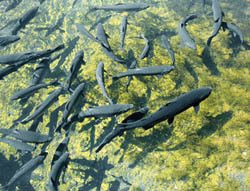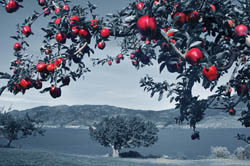The Entiat Valley Habitat Farming Enterprise Program is a vehicle to create successful transactions between willing sellers of riparian habitat and those willing to pay for restoration of fish, improved wildlife habitat, and clean water.
Streams that once meandered across open valley floors, providing essential fish habitat, are now channelized by roads, railroads, and agricultural operations. This loss in tributary habitat is a limiting factor in efforts to recover declining fish populations in the Pacific Northwest.
In the Entiat River Valley, a tributary of the Columbia River Basin, agricultural activities and transportation development simplified the riverine system and erased significant fish habitat. An environment essential to river system health and the survival of salmon and steelhead populations was gradually replaced; healthy cottonwoods and dense, overhanging shrubs gave way to fruit trees.
For several generations, many farmers within the Entiat Valley enjoyed fishing for wild steelhead and salmon from the banks of their orchards. In fact, orchardists planted apple, pear, and cherry trees right up to the river bank, as this was the general practice. While farming continued in the Entiat Valley and throughout the Northwest, recognition was building that the fish in the Columbia River Basin were in precipitous decline. With this awareness came tension between salmon recovery efforts and farming operations. Despite such tensions, the Entiat Valley community endorsed salmon recovery efforts in their watershed.
Habitat Farming Enterprise
The landowners of the Entiat Valley, organized through the Entiat Watershed Planning Unit, teamed up with the Institute for Rural Innovation and Stewardship to find ways to integrate fish and wildlife habitat restoration with economically sustainable strategies for orchardists. Their collaborative efforts produced the Habitat Farming Enterprise Program—a venture designed to provide growers with an appropriate economic return for planting and maintaining riparian habitat as an alternative to growing traditional crops.
Such incentive programs to compensate landowners for improvements to habitat are not new. The Federal Conservation Reserve Enhancement Program, for example, seeks to provide landowners with cost-share assistance and rental payments for installation and maintenance of long-term conservation practices, such as riparian habitat. Seemingly an ideal fit, this conservation program has gained little traction. In Chelan County, where the Entiat Watershed resides, there are only two such contracts under the Conservation Reserve Enhancement Program, totaling 4.5 acres.
The principal reason for the underutilization of existing incentive programs in the Entiat Valley and the surrounding watersheds of the Upper Columbia region is economic in nature. Orchardists identify low rental rates, high administration costs, and shortage of technical support as key problems.
Tellingly, the Conservation Reserve Enhancement Program has been successful in other areas. For example, dryland wheat farmers in Walla Walla County, located south of Chelan County, have more than 100 river miles of riparian habitat in the Conservation Reserve Enhancement Program. For those farmers, where both the cost of farming and property values are lower, the reserve program rental rates appear sufficient to cover the opportunity costs for dryland farming. As such, the growers in Walla Walla County are not being asked to bear the cost for restoration and long-term management. That is not true for more costly irrigated farming operations such as tree fruit production in the Entiat River Valley.
The landowners of the Entiat Valley teamed up with the Institute for Rural Innovation and Stewardship to find ways to integrate fish and wildlife habitat restoration with economically sustainable strategies for orchardists.
Rather than acquiesce to the fact that existing incentive programs are not necessarily designed for tree fruit crops, the Entiat Watershed landowners developed a conservation plan that responds to the actual costs of conservation in the Upper Columbia region.
Feasibility for Farmers
The Entiat Valley growers, operating under the principle that they need to succeed economically while farming ecologically, worked with multiple partners to develop a feasibility study. Chelan County provided the funding for the study, which explored ways that the Habitat Farming Enterprise Program could be set up and operated to provide value to both farming operations and to fish and wildlife habitat. This study investigated the ways that the program could be structured, and considered eligibility, program administrations, and technical assistance for project implementation. One of the study’s key recommendations was to develop a remuneration model to accurately compensate the farmers for switching a small part of their agricultural production from tree fruit crops to production of riparian habitat.
The Institute for Rural Innovation and Stewardship, in consultation with the Entiat Watershed Planning Unit, hired Six Mile Consulting Group working in conjunction with the Property and Environment Research Center, to complete the economic remuneration model. Six Mile Consulting developed a model for estimating the costs of converting commercially viable orchards into riparian habitat for fish and wildlife. The model estimates opportunity costs as well as costs associated with installation and maintenance of riparian habitat.
With the study and model complete, the key task for the Habitat Farming Enterprise Program is to find funding for this effort. The Upper Columbia Salmon Recovery Board in partnership with the Institute for Rural Innovation and Stewardship, the Chelan-Douglas Land Trust, and the Entiat Watershed Planning Unit, are working to secure funds.
Best Bang for the Buck
If successfully implemented, the Habitat Farming Enterprise Program will have significant and broad reaching economic and ecological benefits throughout the region. Importantly, it would reduce the unintended consequences of outright acquisition of parcels. Salmon recovery dollars are often used to purchase riparian habitat and associated uplands. When this happens, those lands are permanently taken out of agriculture. In so doing, these acquisitions decrease the agricultural lands available for production and erode a key driver for the local economy. Declines in tax revenue have proven to be a significant problem in Chelan County, where the Entiat Valley is located. At the same time, such acquisitions inevitably reduce the supply of marketable property, driving up land prices and further impacting the local economy.
the Habitat Farming Enterprise Program will have significant and broad reaching economic and ecological benefits throughout the region.
By contrast, habitat farming would keep nontarget uplands in agricultural production. In addition to growing fruit trees, these farmers would be growing and maintaining riparian habitat, hence avoiding “over buying” of land. Rather than purchasing the entire parcel, the program would encourage habitat farming on the most critical riparian areas, while allowing the remainder of the parcel to stay in traditional agricultural use. Conservation dollars are thus focused where they can do the most good.
The Habitat Farming Enterprise Program would also have significant conservation benefits. The Chelan-Douglas Land Trust, one of the largest local proponents of the acquisition model, recognizes the need for additional land conservation tools beyond fee simple acquisition and permanent conservation easements. Long-term stewardship of lands is not without cost. The local land trust views habitat farming as a solid approach to long-term maintenance of riparian habitat. Moreover, farmers who work on-site, are more readily available to maintain the riparian zones adjacent to their orchards.
Riparian farming also creates ecological benefits by sheltering waterways from pesticides and fine sediment and by shading the water—contributing to cooler temperatures in the summer. Native vegetation, especially large cottonwoods, is the key component to building instream complexity and habitat for fish.
A few protected parcels along miles of river will not be enough to save endangered salmon and steelhead. Rather, miles of riparian habitat restoration are needed. The Habitat Farming Enterprise Program is a vehicle to create successful transactions between willing sellers of riparian habitat and those willing to pay for restoration of fish, improved wildlife habitat, and clean water.





